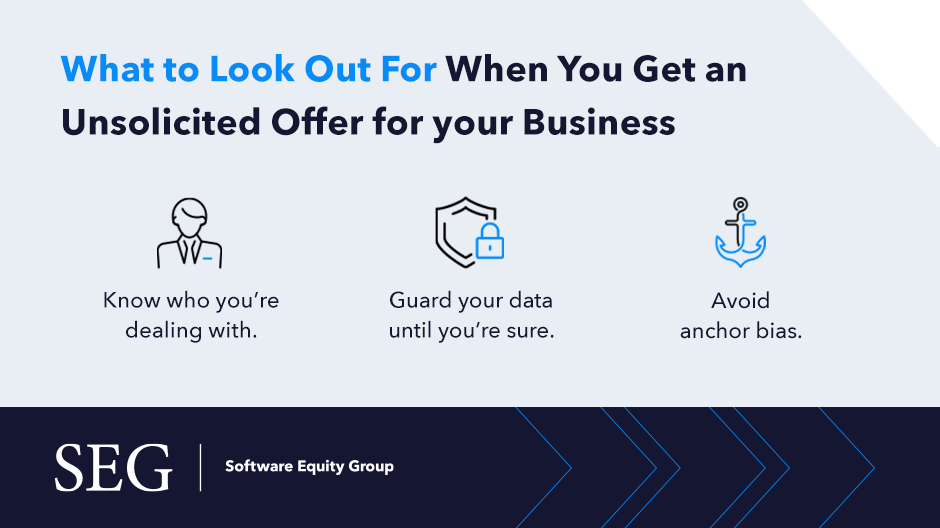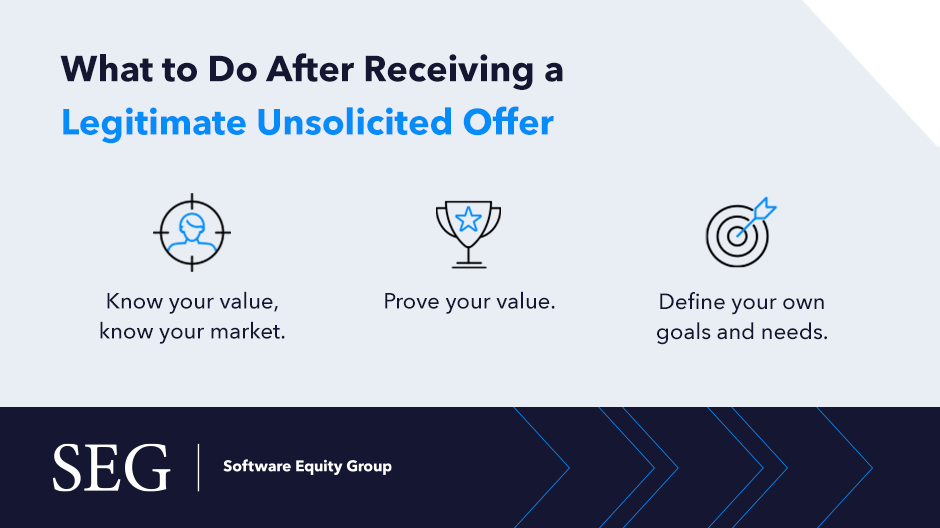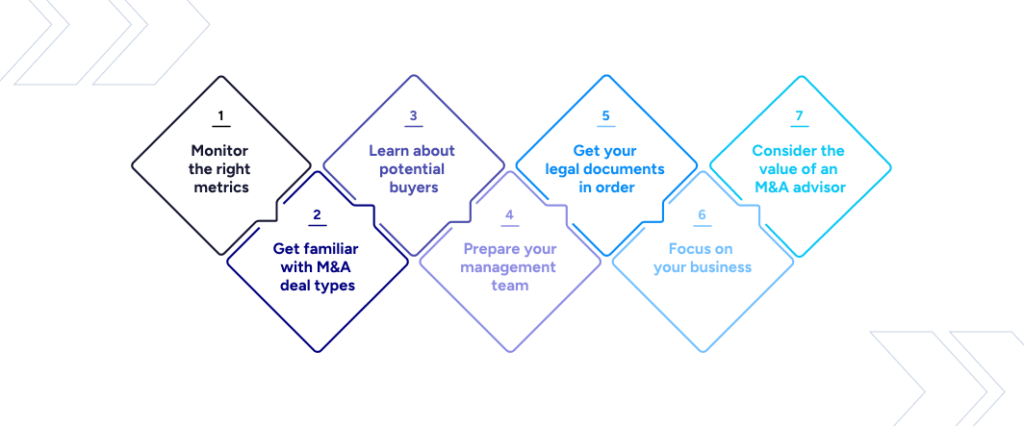- Company
Featured Resource
CLIENT STORYModern Message
To Real Estate
Giant RealPage
- Sectors
Featured Industry Report
EXPERT SERIESManufacturing Software
Report – Part 2
- Research
Featured Resource
FEATURED REPORTThe SEG 2024
Annual SaaS Report
- Tools
Featured Resource
WHITEPAPER20 Factors to Track When Valuing Your
SaaS Company
- Blog
Receive an Unsolicited Offer for Your SaaS Business? What to Do Next

Here’s a situation most SaaS founders are likely familiar with: You start a business solving a key problem in an industry. You build the right team, the right software product, and monetize it. Then, while you’re heads-down in the thick of it all, you receive an unsolicited offer asking to buy your business—likely from a private equity firm.
For SaaS founders who want to sell, an unsolicited offer from PE firms can be exciting, nerve-inducing, and stressful all at once. But what happens now? And what’s the best way to move forward?
If that sounds like you, read on as we explore why SaaS founders receive unsolicited offers, how to assess potential offers, and the next steps to take after a genuine, attractive offer is made.
Why SaaS Founders Receive Unsolicited Offers
Unsolicited offers aren’t anything new in the business world. In recent years, SaaS has been in the spotlight for mergers and acquisitions, making them a frequent target of unsolicited bids.
PE firms, in particular, have displayed an interest in SaaS. Last year marked the first time PE investment crossed the $100 billion mark at $167 billion. As tech PE funds continue to grow, there are fewer companies to invest in, creating some tense competition among firms. Hence, founders receive multiple unsolicited offers.
Aside from an increasingly competitive buyer’s market, SaaS companies are attractive to potential buyers for various reasons. These include building or simplifying the buyer’s tech stack, the promise of the SaaS business model, and potential return on investment.
Tech is here to stay.
In today’s remote world, SaaS is no longer an industry unto itself but rather an integral part of the infrastructure every business is made up of. Indeed, SaaS proved its value to companies (and potential buyers) in the pandemic. It isn’t going anywhere in 2022 or the near future.
The SaaS business model is poised for success.
Unsolicited offers are often made to SaaS companies because of their highly effective business model. Since SaaS has no physical manufacturing costs, it has the potential for massive economies of scale by either adding more customers or more features. This quick, scalable, and profitable business model makes SaaS companies a no-brainer investment.
SaaS companies have predictable revenue. Annual subscription models vs. one-time purchases mean growth is determined by adding more users, more products, or increasing the subscription prices. This stability is enticing to potential buyers who want a steady revenue stream incorporated into their existing business.
SaaS companies are easier to scale. Overhead costs are relatively low, and scaling can in some cases be as simple as adding a new product feature. This means there is significant potential in a good software product with built-in customers ready to up-sell as soon as a new feature is live.
In summary, the SaaS business model is low risk, high margin, and fast scaling — a perfect match for buyers looking to acquire something stable. But does SaaS actually produce results?
SaaS has a track record of proven IRR.
The SaaS business model is just as effective in real life as it looks on paper. Or at least it is if the major investments in SaaS companies over the last year are any indication.
Private equity companies alone invested a whopping $1.2 trillion into software companies in 2021. Startups are acquiring other startups to bolster the tech sector. And if they’re not investing or buying SaaS themselves, companies are subscribing to tech solutions to improve day-to-day operations.
Unsolicited offers are something SaaS founders should expect if they’re providing value to their customers. However, not all unsolicited offers are created alike, and founders should be wary when it comes to evaluating offers they weren’t expecting.
Evaluating an Unsolicited Business Offer
While receiving an unsolicited offer can feel great, it’s important to understand the underlying reasons why a PE firm or other buyer might reach out to you. Not all interested parties might disclose their true motives upfront, and it’s important that you evaluate every angle before moving forward.
You can bet potential buyers will be acting in their own best interest when they reach out to you first. You need to make sure to look out for yours. Here’s a few tips on what that looks like.

Know who you’re dealing with.
First, make sure you’re talking with the right people at the potential buyer’s company. It’s common practice at PE firms for junior-level employees to cold call dozens of companies with potential offers. For them, it’s a numbers game—the more calls they make, the more likely they are to get a deal.
If a buyer is serious, you’ll want to make sure to build relationships with decision-makers. That way, you can get a sense of their genuine interest and how well you’ll work together.
Guard your data until you’re sure.
Some PE firms that reach out with an offer aren’t actually interested in your company at all. Rather, they could be looking to invest in a competitor and want to know more details about your company for leverage. They might just be gathering information for a portfolio company, or simply conducting research in your space.
Until you can be certain the offer isn’t part of one of those scenarios, make sure to keep company data close to your chest. Specifically, never share raw data or forward-looking statements. This will benefit you in negotiations long-term, as well as ensure you protect your best interests in the interim.
Avoid anchor bias.
The first offer often sets the tone for the entire buying process—sometimes disproportionately. Because PE firms and other buyers know this, they’ll try to get an offer in early on for leverage.
When time is on their side, buyers are more able to develop relationships inside your company, stay involved through the whole buying process, or persuade key players that they’re the best option. By acknowledging anchor bias, you can make sure to hold all options equally based on merit, not on when the offer rolled in.
What to Do After Receiving a Legitimate Unsolicited Offer
If you’ve assessed the legitimacy of the offer and decided it’s genuine, it’s important to take the right steps to either accept, reject, or negotiate the offer further. Remember, only you can represent your best interests, so it’s up to you to ensure you’re getting your money’s worth. Selling is a huge undertaking with serious ramifications.
Here are three things you should do after getting a true offer to purchase your business.

1.Know your value, know your market
Understanding the value of your business is a great first step for sellers. If you aren’t already doing a regular check-in to calculate how much your business is worth, now is a great time to start. That way, when unsolicited offers roll in, you can immediately know whether it’s in the vicinity of your true value or not.
Likewise, understanding the ins and outs of your market is critical to a successful outcome. Markets, competition, and buyer demand is always evolving. Knowing where you stand in the grand scheme of things will help you understand exactly when and why to pull the trigger and sell. Some questions you might ask yourself are:
- How are competitors valued?
- What competitors have raised capital and at what valuation?
- How does my company profile compare to related acquisitions in the market?
- What makes my company more or less valuable?
By knowing your value and market, you can also make sure to avoid lowball offers and bring your own expertise to the negotiating table. Working with an M&A advisor is a great way to ensure you’ve got accurate information. Keeping tabs on public market and M&A software multiples is another way to stay up to date.
2.Prove your value
If the offer is attractive, you should be prepared to prove that you’re actually worth what they want to buy you for, if not more. As with any deal, you’ll have to provide plans and proof that you can increase revenue in three to five years down the road, complete with plans about resources, new products and features, and more.
As a quick checklist, you should be prepared to:
- Monitor key KPIs like ARR, churn, COGS, and revenue
- Prepare any necessary legal documents in advance
- Make sure the sale isn’t distracting from day-to-day operations
3.Define your own goals and needs
Lastly (and perhaps most importantly) you need to take a hard look at your priorities and ask yourself what you want out of a potential deal. This will help shape the structure of the deal and help you know what to negotiate for.
Some quick tips:
- Keep parties honest by running a process to generate competition.
- Determine your personal and business priorities. Will you walk away after closing? Do you want to pass on the business to family or employees? What will happen to the brand?
- Gather your team of advisors to ensure you get the best advice. This can include an M&A advisor, M&A attorney, tax advisor, and accountant.
- Talk with your personal financial advisor, not just your business advisors. How much cash do you need personally? How does that factor into the deal?
- Know the tax implications of the deal by working with your M&A attorney or CPA.
In conclusion, more and more SaaS founders are receiving unsolicited offers to buy their business. After all, SaaS is an attractive model with great returns. However, all offers should be thoroughly examined to ensure their legitimacy and scrutinize their sum value. In the end, making a deal is a complex process that involves a great deal of thought and care.
If you’re interested in pursuing a deal to sell your SaaS company, Software Equity Group has a 30-year track record of helping software companies navigate the complexities of mergers and acquisitions. Reach out to learn more about how we help here.







